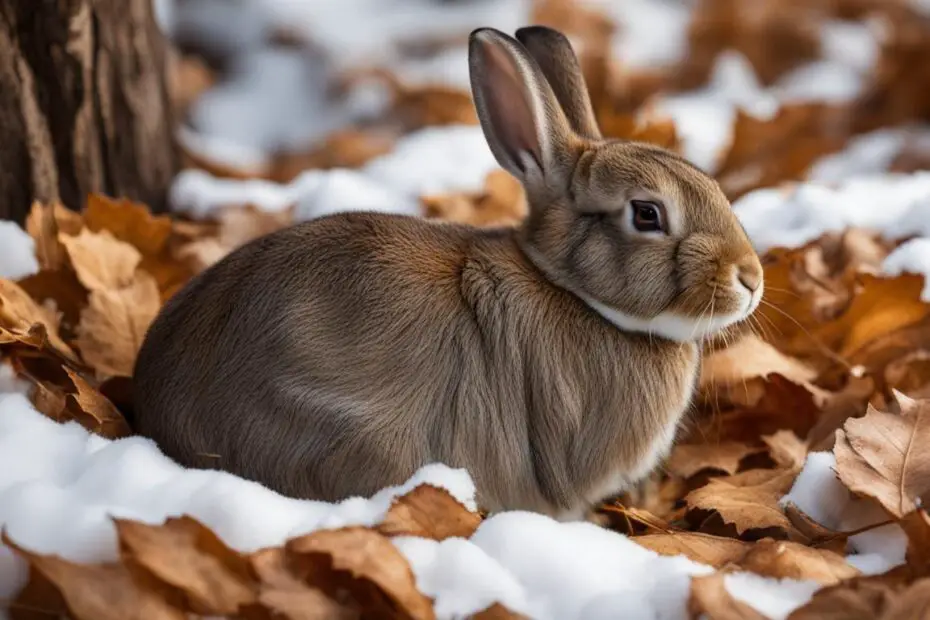Have you ever wondered where rabbits go in winter? Contrary to popular belief, rabbits don’t hibernate during the cold months. These resilient creatures remain active year-round, adapting their behavior and survival strategies to endure the winter season.
When the snow blankets their usual food sources, rabbits must get creative to find sustenance. They rely on grass and other ground plants as their primary food, but when these resources become scarce, rabbits adapt by foraging on tall plants, twigs, bark, and tree buds that remain visible even after a snowfall. To stay safe from predators, rabbits seek shelter in thick bushes, evergreen trees, and solid fences.
Despite the cold temperatures, rabbits are hardy animals and use their thick fur coats to stay warm. Although they reduce their activity to conserve energy, they don’t hibernate like some other animals. Instead, they remain alert and on the move, utilizing their winter survival strategies to brave the winter months.
Key Takeaways:
- Rabbits don’t hibernate in winter but adapt their behavior to seek food and shelter.
- They rely on grass and ground plants but get creative when these resources are covered by snow.
- Rabbits seek shelter in thick bushes, evergreen trees, and solid fences to hide from predators.
- Their thick fur coats help them withstand cold temperatures.
- Rabbits reduce their activity to conserve energy but remain active and alert throughout the winter season.
Where Rabbits Go in Winter
Rabbit Behavior in Winter: Feeding Habits and Winter Adaptations
During the winter months, rabbits undergo a series of behavioral changes to adapt to the challenges posed by the cold weather. Their feeding habits and survival strategies enable them to thrive even in harsh conditions.
Rabbits shift their food sources in winter due to the scarcity of their preferred vegetation. They become less selective and more resourceful, consuming coarser diets such as twigs, wood chips, and bark. When other food sources are scarce, rabbits may even resort to consuming their own excrement for vital nutrients. This adaptation ensures they can acquire essential sustenance despite the limited availability of their usual diet.rabbit hibernation
To cope with the cold temperatures, rabbits rely on their winter adaptations. Their thick fur coats provide insulation, keeping them warm during freezing weather. Additionally, rabbits reduce their activity levels to conserve energy and rely on their stores of fat to maintain their internal body temperature. These behavioral and physiological changes allow them to resist the cold and survive through the winter months.
| Rabbit Behavior in Winter | Winter Adaptations |
|---|---|
| Shifted food sources | Consumption of coarser diets such as twigs and bark |
| Reduced activity levels | Conservation of energy through decreased movement |
| Thick fur coat | Provides insulation and warmth |
| Store of fat | Maintains internal body temperature |
“Rabbits are remarkable creatures when it comes to adapting to winter conditions. Their ability to shift their food sources, consume coarser diets, and reduce activity levels showcases their resourcefulness and resilience in the face of cold weather.”
By understanding rabbit behavior in winter and their winter adaptations, we can appreciate the extraordinary ways in which these animals are able to survive and thrive in challenging environments. Their ability to adapt their feeding habits and utilize their natural defenses ensures their continued existence and inspires awe in those who witness their remarkable strategies for winter survival.winter survival of rabbits
Rabbit Migration Patterns: Where Do Rabbits Go in Winter?
Rabbits, unlike birds, don’t migrate long distances in search of warmer climates during winter. Instead, they exhibit movement patterns within their established home range to find better resources and habitats. Although they may not travel great distances, rabbits do hide in specific locations to seek out food and shelter during the colder months.
One common winter hiding place for rabbits is their underground burrows, which they have already lined with straw and grass for insulation. These burrows not only provide warmth but also offer protection from the cold. By staying within their preferred habitat, rabbits maximize their chances of survival by focusing on food availability and protection from predators. where do rabbits hide during winter
Another hiding place for rabbits during winter is dense vegetation, such as thick bushes and evergreen trees. These structures provide cover and camouflage, allowing rabbits to blend in with their surroundings and avoid detection by predators. Additionally, solid fences that predators cannot see through offer additional protection.
| Rabbit Migration Patterns | Where Do Rabbits Go in Winter? |
|---|---|
| Underground burrows | Provides warmth and insulation |
| Dense vegetation | Offers cover and camouflage |
| Solid fences | Provides additional protection |
Winter Habitats for Rabbits: Choosing the Right Shelter
During the winter months, rabbits need to find suitable habitats that provide both food and shelter to survive the cold temperatures. They have specific preferences when it comes to their winter shelters, ensuring they have the best chance of staying warm and protected from predators.winter shelters for rabbits
Rabbits look for thick bushes, evergreen trees, and solid fences as their preferred shelters during winter. These structures offer both cover from the harsh weather conditions and security from potential predators. They seek out areas where the vegetation is dense enough to provide adequate hiding spots, but also where predators cannot see through the shelter.
In addition to above-ground shelters, rabbits also utilize underground dens as a means of protection and insulation. These burrows provide warmth and offer refuge from the cold winter temperatures. Rabbits line their burrows with grass, straw, and twigs, creating a cozy and insulated environment.rabbit winter adaptations
| Winter Habitats for Rabbits | Features |
|---|---|
| Thick Bushes | Provides cover and camouflages rabbits |
| Evergreen Trees | Offers shelter from harsh weather conditions |
| Solid Fences | Prevents predators from seeing through |
| Underground Burrows | Insulated and provides refuge from cold temperatures |
Rabbits are intelligent creatures that adapt to their surroundings. In some cases, they may even take advantage of human yards that provide a combination of food sources and hiding places. However, it’s important to strike a balance between appreciating their presence and implementing measures to prevent excessive damage to plants and property.
The Importance of Suitable Winter Habitats
Having appropriate winter habitats is crucial for rabbits to survive the harsh winter conditions. By selecting the right shelters, they can minimize the risk of exposure, maintain their body temperature, and avoid potential predators. These habitats offer the necessary resources for rabbits to conserve energy during the winter months and ensure their survival until the arrival of spring. rabbits and cold weather
Rabbit Winter Survival Adaptations: Coping with Cold Temperatures
During the winter months, rabbits employ various adaptations to survive the cold temperatures and maintain their well-being. One key adaptation is their thick fur coat, which provides insulation and helps to keep them warm even in freezing conditions. The dense fur helps trap body heat, allowing rabbits to maintain a comfortable internal body temperature.
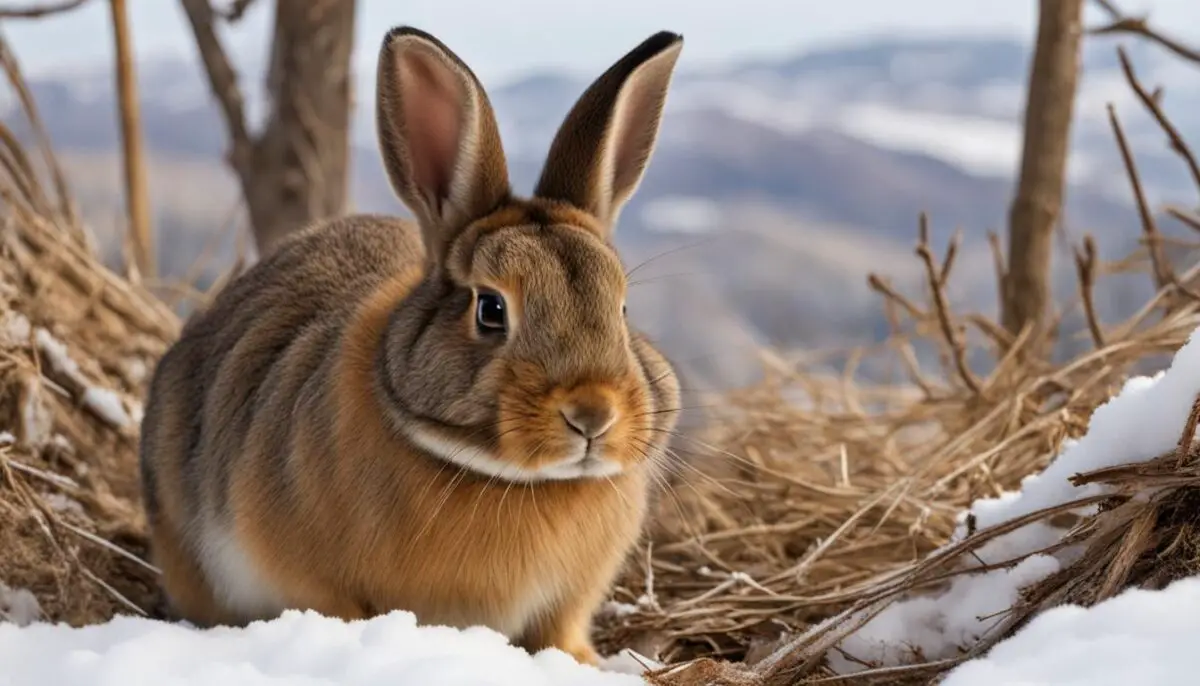
In addition to their fur, rabbits also reduce their activity levels to conserve energy. By minimizing physical exertion, rabbits can preserve their body heat and minimize the energy needed to stay warm. This adaptive behavior allows rabbits to endure the cold temperatures and harsh winter conditions without expending excessive energy.
Table: Rabbit Winter Survival Adaptations
| Adaptation | Description |
|---|---|
| Thick Fur Coat | Insulates the body and provides warmth |
| Reduced Activity | Conserves energy and minimizes heat loss |
| Lowered Metabolic Rate | Decreases the need for food and energy consumption |
| Seeking Sheltered Areas | Hiding in burrows or dense vegetation for protection from the cold and predators |
When temperatures drop, rabbits also lower their metabolic rate, which helps reduce their need for food and energy consumption. By slowing down their metabolic processes, rabbits can survive on smaller amounts of food during the winter months when food sources may be scarce.
Rabbits also seek out sheltered areas to protect themselves from the cold weather and predators. Underground burrows, which they dig or repurpose from other animals, provide insulation and a safe refuge from the elements. These burrows help maintain a stable temperature, shielding the rabbits from extreme cold and wind.
In conclusion, rabbits have developed various adaptations to cope with the cold temperatures of winter. Their thick fur, reduced activity levels, lowered metabolic rate, and preference for sheltered areas all contribute to their survival in harsh winter conditions. These adaptations allow rabbits to thrive in colder climates and ensure their continued presence in ecosystems throughout the winter season.
Winter Behavior of Wild Rabbits: Seeking Food and Hoping to Stay Hidden
During the winter months, wild rabbits exhibit interesting behavior patterns as they navigate the challenges of finding food and protecting themselves from predators. With the loss of vegetation density, rabbits become more vulnerable to predators in the open. To counter this, they seek hiding places that provide cover and camouflage. Thick bushes, evergreen trees, and solid fences become essential hiding spots for rabbits, allowing them to blend into their surroundings and increase their chances of survival.
In their quest for food, rabbits become less selective and more creative in their choices. They adapt to the scarcity of vegetation by feasting on tall plants, twigs, bark, and tree buds that remain visible even after a snowfall. These alternative food sources help them sustain themselves until the arrival of spring when vegetation becomes more abundant. By exploring different food options, rabbits demonstrate their resourcefulness and adaptability to changing conditions.
“The loss of vegetation density in winter makes rabbits more vulnerable to predators, leading them to seek hiding places.”
As winter takes its toll, rabbits face the constant challenge of finding enough food to survive. Their behavior reflects their determination to seek sustenance while also staying hidden from potential threats. By understanding their winter behavior, we can appreciate the resilience and adaptability of these fascinating creatures.
| Winter Behavior of Wild Rabbits | Key Points |
|---|---|
| Seeking hiding places | Thick bushes, evergreen trees, and solid fences provide cover and camouflage. |
| Expanding food choices | Rabbits consume tall plants, twigs, bark, and tree buds to sustain themselves. |
| Resourcefulness and adaptability | Rabbits demonstrate their ability to thrive in challenging winter conditions. |
Observing the winter behavior of wild rabbits reminds us of their resilience in the face of adversity. Their survival strategies highlight their ability to find food sources in unexpected places and utilize natural hiding spots. As we continue to admire these creatures, it’s important to respect their habitats and provide spaces where they can thrive without causing damage to our yards. By striking a balance between appreciation and practical measures, we can ensure a harmonious coexistence with wild rabbits during the winter months.
The Difference Between Rabbits and Hares: Unique Winter Behaviors
While rabbits and hares both belong to the same family, they exhibit distinct behaviors, particularly in winter. Understanding these differences can provide valuable insights into their survival strategies. Let’s take a closer look at how rabbits and hares adapt to the challenges of winter.
Behavior Differences
| Rabbits | Hares |
|---|---|
| Rabbits live in larger groups and prefer underground burrows or nests for shelter. | Hares are larger and often live alone or in pairs above ground. |
| Rabbits rely on their ability to hide in burrows and use them as a defense against predators. | Hares rely on their incredible speed to evade predators. |
| Rabbits exhibit a cautious behavior, blending into their surroundings to avoid detection. | Hares are more alert and have a unique ability to stand on their hind legs to get a better view of their surroundings. |
Rabbit burrows are essential for their survival in winter. These underground shelters provide insulation from the cold and protection from predators. Hares, on the other hand, rely on their agility and speed to escape predators. They do not require burrows for shelter and often find hiding places among rocks, tall grasses, or dense vegetation.
“Rabbits and hares may differ in their winter behaviors, but each species has unique adaptations that help them navigate through the challenges of the season.” – Wildlife Expert
Conclusion
In conclusion, while rabbits and hares have some similarities, they display distinct behaviors when it comes to winter survival. Understanding these differences enhances our knowledge of these fascinating creatures and their ability to adapt to their environment in unique ways.
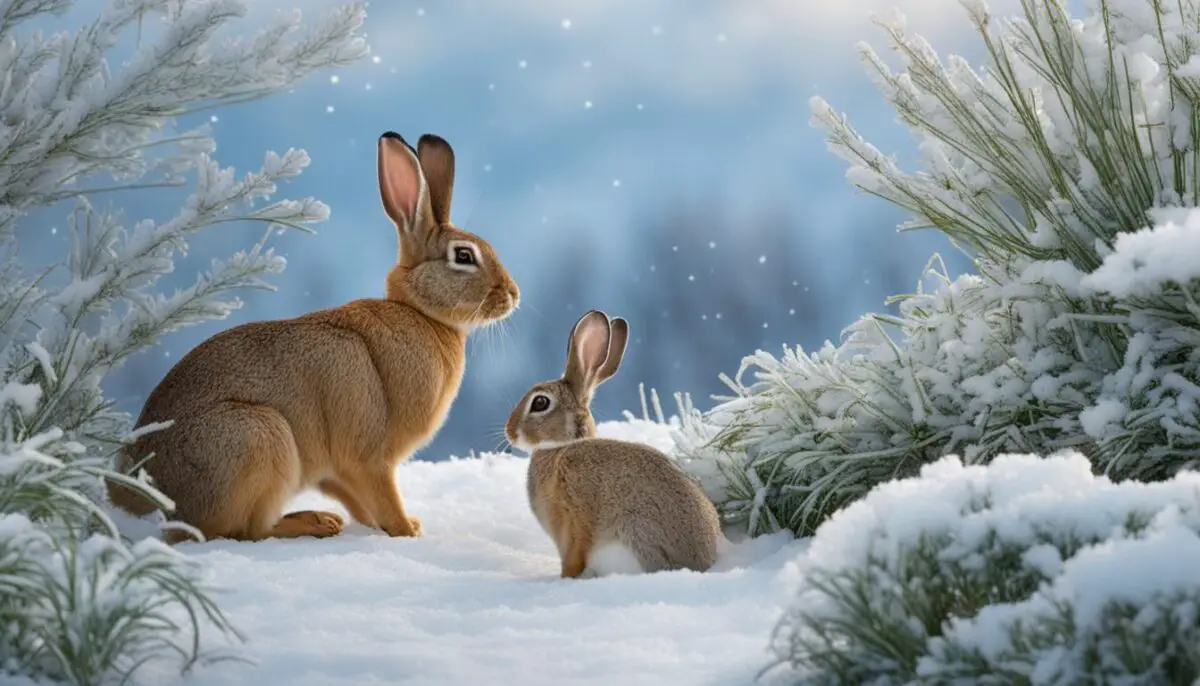
Dealing with Rabbits in Your Yard: Prevention and Control Methods
If you find rabbits causing damage to your yard, there are several effective prevention and control methods you can employ to keep them at bay. By implementing these measures, you can protect your plants and property from rabbit damage during the winter months.
Preventing Rabbit Damage in Your Yard:
To prevent rabbits from damaging your plants, one of the most effective methods is to install wire-mesh fencing around vulnerable areas. This can create a physical barrier that rabbits cannot easily penetrate. Additionally, clearing fallen twigs and branches regularly can discourage rabbits from seeking shelter in your yard, as these can provide hiding spots for them. Trimming ornamental shrubs can also remove potential food sources, making your yard less attractive to rabbits.
It’s important to note that traditional fences may not be effective in keeping rabbits out, as they can easily squeeze beneath them. In these cases, alternative methods can be employed. For example, having a dog in the yard can act as a natural deterrent to rabbits, as their presence can intimidate and scare them away. However, it’s important to ensure that the dog is properly trained and does not pose a threat to the rabbits or other wildlife.
Avoiding Trapping and Focusing on Humane Measures:
While trapping may seem like a solution for dealing with rabbits, it is generally discouraged, as it can lead to harm or unnecessary stress to the animals. Additionally, trapping and relocating rabbits can spread diseases to new areas, which can further disrupt the local ecosystem. Instead, focusing on humane exclusionary measures is key.
By creating an environment that is less inviting to rabbits, you can encourage them to find alternative food sources and habitats. This allows them to maintain their natural behaviors while protecting your plants and property.
| Prevention Methods for Rabbit Damage in Your Yard | Effectiveness |
|---|---|
| Install wire-mesh fencing | Highly effective |
| Clear fallen twigs and branches | Moderately effective |
| Trim ornamental shrubs | Moderately effective |
| Have a dog in the yard | Highly effective |
| Avoid trapping and relocation | Discouraged |
By employing these prevention and control methods, you can strike a balance between appreciating the presence of rabbits and minimizing any negative impact they may have on your yard. Creating a harmonious coexistence between humans and wildlife is essential for maintaining a healthy ecosystem.
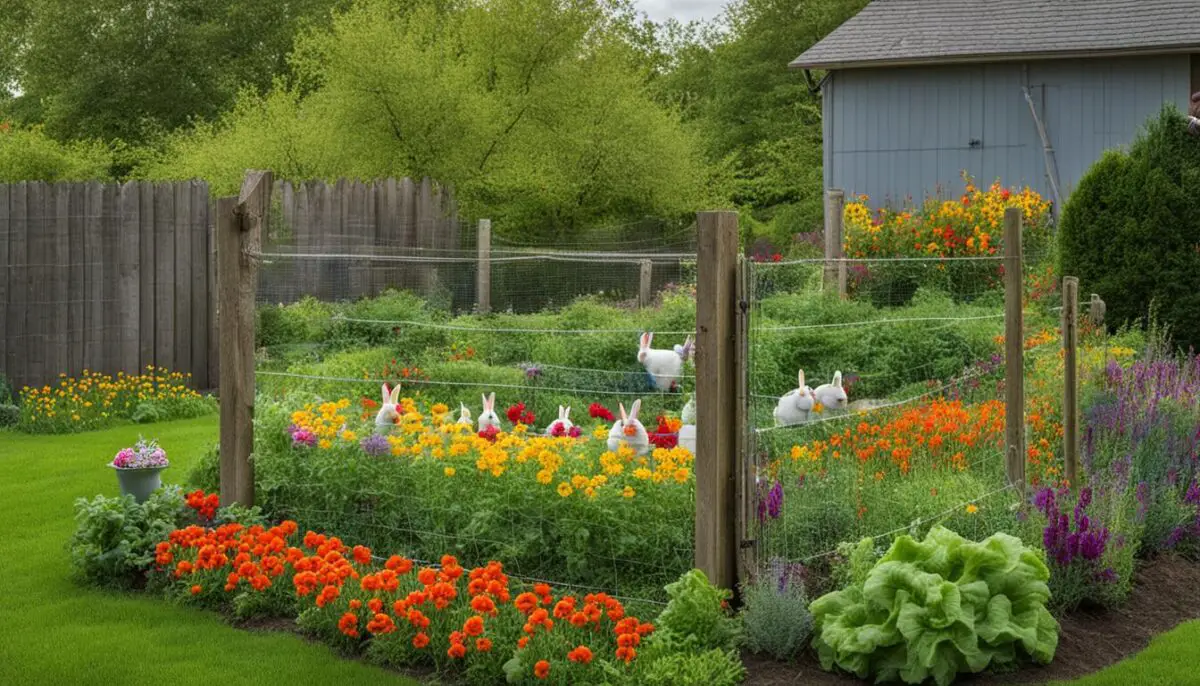
Rabbits in Winter: Balancing Appreciation and Pest Control
As winter settles in, rabbits roam our yards, showcasing their intriguing adaptations and survival strategies. While their presence may evoke appreciation for these adorable creatures, it’s essential to strike a balance between admiration and implementing pest control measures to protect our plants and property.
Rabbits in winter demonstrate remarkable behaviors that enable them to cope with the cold temperatures and scarcity of food sources. They shift their diets, becoming less selective and more resourceful in their food choices. Consuming twigs, bark, and tree buds, they adapt to the lack of vegetation, ensuring their survival even in harsh conditions.
To effectively manage rabbits in our yards, prevention is key. Installing wire-mesh fencing around vulnerable areas can deter these curious nibblers from damaging our plants. Regularly clearing fallen twigs and branches, as well as trimming ornamental shrubs, can also discourage rabbits from seeking shelter in our yards. Traditional fences may not prove effective as rabbits can easily squeeze beneath them, so it’s important to employ alternative methods like having a dog in the yard or utilizing exclusionary measures.
| Prevention Methods for Managing Rabbits in Yards | Effectiveness | Challenges |
|---|---|---|
| Installing wire-mesh fencing | Highly effective for protecting vulnerable areas | May require additional maintenance over time |
| Clearing fallen twigs and branches regularly | Discourages rabbits from seeking shelter | Requires consistent upkeep |
| Trimming ornamental shrubs | Deters rabbits from damaging plants | May alter the aesthetic appeal of the shrubs |
| Utilizing alternative methods like having a dog in the yard | Acts as a deterrent to rabbits | Requires responsibility and commitment as a pet owner |
| Exclusionary measures | Allows rabbits to find food elsewhere while protecting plants | May require initial investment and skill to implement |
By understanding rabbit behaviors, implementing preventive measures, and appreciating their presence while managing potential pest-related issues, we can achieve a harmonious coexistence with these fascinating creatures during the winter months.
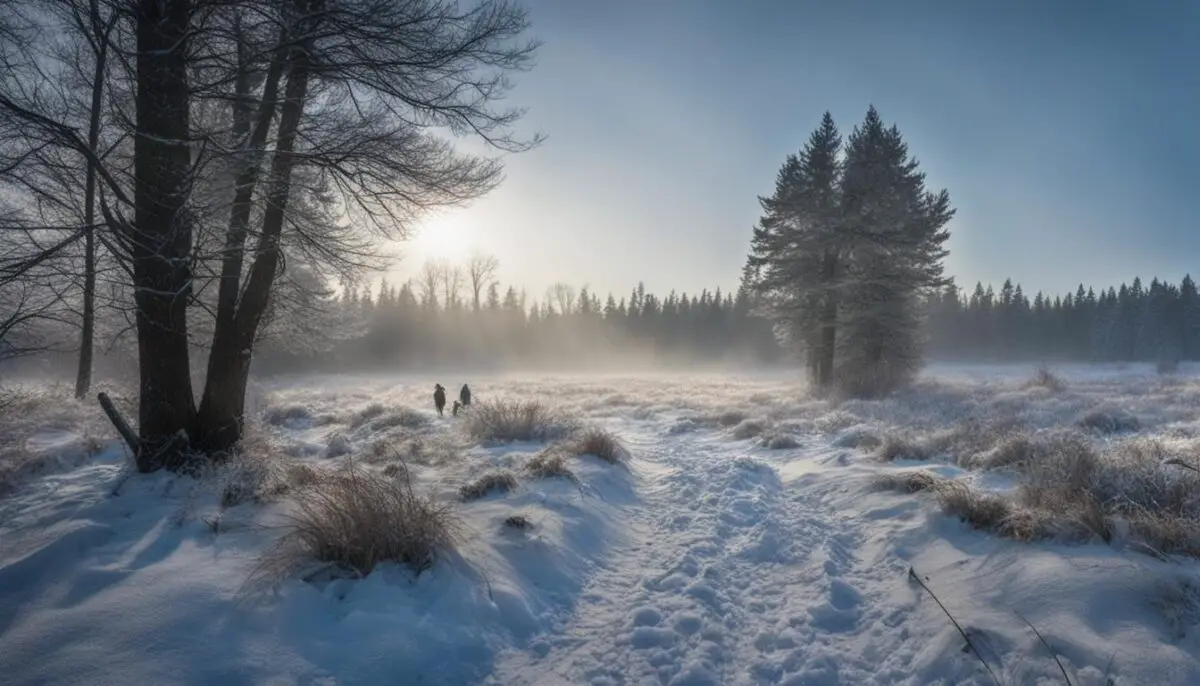
Conclusion
In conclusion, rabbits are fascinating creatures that exhibit remarkable survival strategies during winter. Unlike hibernating animals, rabbits remain active year-round, adapting their behavior to cope with the challenges of the cold season.
Rather than hibernating, rabbits adjust their feeding habits and seek out alternative food sources when their primary choices are unavailable. They rely on their winter adaptations, such as their thick fur coats and ability to reduce activity, to conserve energy and stay warm in freezing temperatures.
Rabbits also exhibit movement patterns within their home range, searching for better food sources and suitable shelters. They prefer habitats that offer both food and protection, such as thick bushes, evergreen trees, and underground burrows lined with insulation materials.
While rabbits can be pests in yards, causing damage to plants, effective prevention methods can help mitigate conflicts. Installing wire-mesh fencing, clearing fallen debris, and utilizing exclusionary measures can discourage rabbits from accessing vulnerable areas. By striking a balance between appreciation for these fascinating creatures and implementing proper pest control measures, humans and rabbits can coexist harmoniously.
FAQ
Do rabbits hibernate in the winter?
No, rabbits do not hibernate in the winter. They remain active year-round.
What do rabbits eat in the winter?
During the winter, rabbits rely on grass and other ground plants as their primary food source. When vegetation is covered by snow, they get creative and look for tall plants, twigs, bark, and tree buds that remain visible. They may also eat coarser diets like twigs and wood chips.
How do rabbits stay warm in the winter?
Rabbits have thick fur coats that provide insulation and help them stay warm in freezing temperatures. They also reduce their activity to conserve energy and may seek shelter in underground burrows lined with straw and grass.
Do rabbits migrate in the winter?
While rabbits don’t migrate in the traditional sense, they exhibit movement patterns within their home range to find better food sources and shelter. They stay within their preferred habitat to maximize their chances of survival.
Where do rabbits hide during winter?
Rabbits seek shelter in thick bushes, evergreen trees, solid fences, and underground burrows during winter. These structures provide protection from predators and harsh weather conditions.
What are some rabbit winter adaptations?
Rabbits have thick fur coats that help them tolerate cold temperatures. They also reduce their activity and use their stores of fat to maintain their internal body temperature. Additionally, they line their burrows with straw and grass for insulation.
What is the difference between rabbits and hares in winter?
Hares are larger and live alone or in pairs above ground, relying on their speed to evade predators. Rabbits live in larger groups and prefer underground burrows or nests for shelter.
How can I prevent rabbits from damaging my yard in winter?
Installing wire-mesh fencing around vulnerable areas, clearing fallen twigs and branches regularly, and trimming ornamental shrubs can discourage rabbits from causing damage. Traditional fences may not be effective, as rabbits can squeeze beneath them.
Are rabbits pests in the winter?
While rabbits can cause damage to plants and yards, it’s important to find a balance between appreciating their presence and implementing pest control measures. Understanding their behavior and using prevention methods can help mitigate any negative impact.
How can I coexist with rabbits in winter?
By understanding rabbit behavior and their habitat preferences, you can create a harmonious coexistence. Appreciating rabbits while implementing effective pest control measures ensures the well-being of both rabbits and your property.


